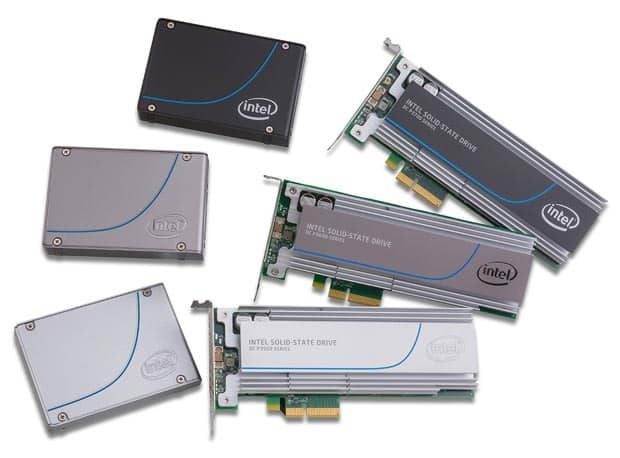Intel has announced a new line of powerful SSD that combine PCI Express with NVM Express (NVMe) technology for substantial performance gains over SATA SSDs and traditional hard disk drives. The Intel SSD Data Center Family for PCIe are designed to meet the increasing needs for high-performance, consistent, and reliable storage solutions in the data center, all the while helping to lower total cost of ownership. The new line includes the Intel SSD DC P3700 Series for write-intensive applications, the Intel SSD DC P3600 Series for mixed workloads, and the Intel SSD DC P3500 Series for read-heavy uses.

The new Intel SSD Data Center Family for PCIe addresses the issues of the massive growth of data, expanding databases, and massive computational and storage needs with high performance that improves processor utilization and scales to address performance and capacity needs. Higher throughput and reduced latency result in faster access to data and improved storage utilization of drives, which lowers total cost of ownership.
The Intel SSD Data Center Family for PCIe uses the PCIe 3.0 specification as well as a new high-performance PCIe interface controller architected with NVMe. This technology allows for consistent performance to overcome storage bottlenecks in the data center. Additionally, NVMe technology was designed with PCIe-based SSDs in mind, which eliminates much of the latency caused by legacy HDD interfaces.
Other features include:
- Eliminating Latencies: PCIe with NVMe moves data and storage closer to the processor, eliminating significant hardware and storage protocol-related latencies and boosting the overall performance of a system, especially with intensive tasks such as virtualization, big data applications and high-performance computing. Consistent performance enables storage response in a more predictable and scalable manner, maximizing system usage and overall performance.
- NVMe 1.0 Industry Standard: The NVMe 1.0 specification defines a scalable architecture that unlocks the potential of PCIe interface SSDs. With a throughput improvement of up to 6x and reduced interface latency that can exceed 6 Gbps SATA SSDs, the Intel SSD Data Center Family for PCIe increases processor utilization while scaling capacity and performance to meet demand.
- Better Utilization of Compute Power: The Intel SSD Data Center Family for PCIe delivers data to the processor faster and with lower latency than SATA interfaces. PCIe with NVMe technology enables the processor to avoid waiting for data, allowing for better utilization of compute power through more consistently high throughput. Increased data throughput and reduced latencies result in faster access to data, better scalability, using fewer drives to deliver the same data throughput, and helping to lower total cost of ownership.
- Data Throughput Improvements: The Intel SSD Data Center Family for PCIe leverages Intel’s third-generation controller and custom firmware, enabling data throughput improvements over traditional HDDs and other SSDs. Through NVMe-based PCIe, the new Intel SSD Data Center Family for PCIe delivers up to 2.8GB per second read speeds, up to 1.9GB per second write speeds and up to 460,000 input and outputs per second (IOPS).
- Compatibility: The Intel SSD Data Center Family for PCIe works with the NVMe drivers provided across operating systems – including Windows and Linux – and with the latest Intel platforms, including the forthcoming server platform code-named Grantley.
- Protection: With multiple check points, the Intel SSD Data Center Family for PCIe protects important data, delivering stress-free data storage. Power loss protection enables data in-flight to be saved in the event of a power loss. The drives also include integrated die parity protection (XOR).
All drives are backed by Intel’s five-year limited warranty and have an average time between failures of 2 million hours, or more than 228 years. The P3700 Series offers 10 full-drive writes per day over the life of the drive, which totals to 36 petabytes, or 459 years of high-definition video. For less demanding sequential workloads, the P3600 Series delivers three drive-writes per day, and the P3500 Series offers 0.3 drive writes per day.
Specifications
- Capacities:
- DC P3700 Series: 400GB, 800GB, 1.6TB, and 2TB
- DC P3600 Series: 400GB, 800GB, 1.2TB, and 2TB
- DC P3500 Series: 400GB, 1.2TB, and 2TB
- Interface: PCIe 3.0 x 4 (4GB/s) NVMe
- 64KB Sequential R/W Performance (figures are “up to”)
- 2800/1900MBps (DC P3700)
- 2600/1700MBps (DC P3600)
- 2500/1700MBps (DC P3500)
- 4K Random R/W Performance (figures are “up to”):
- 460/180K IOPS (DC P3700)
- 450/70K IOPS (DC P3600)
- 450/35K IOPS (DC P3500)
- Average Latency (Read/Write): 20/20µs
- Power Loss Protection Features & Self Test
- Warranty: Five years
The Intel SSD Data Center Family for PCIe will be available in a small 2.5-inch form factor (SFF-8639) for hot-swappable front panel serviceability and an add-in card form factor for broad compatibility with existing PCIe-based systems.
Availability
The Intel SSD Data Center Family for PCIe are available in 400GB, 800GB, 1.2TB (P3500 and P3600 only), 1.6TB and 2TB through Intel distributors and resellers at a starting MSRP of $560.
For more information, visit the product website.




 Amazon
Amazon